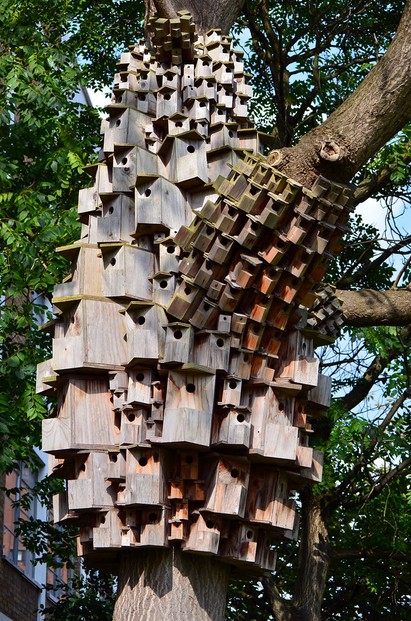bird box city: Images George Rex, CC BY SA 2.0, via Flickr @ https://www.flickr.com/photos/rogersg/14953074737
Old gate, Cremorne Gardens, Chelsea: sited in paved over fragment of original gardens: Fin Fahey, CC BY SA 2.0, via Flickr @ https://www.flickr.com/photos/albedo/116980970/; Tarquin Binary, CC BY SA 2.5, via Wikimedia Commons @ https://commons.wikimedia.org/wiki/File:Chelsea_cremorne_gardens_1.jpg
photo by Jack E. Boucher (September 4, 1931 – September 2, 2012), career photographer with National Park Service: Library of Congress Prints/Photos-Historic American Buildings Survey (HABS), Public Domain, via Wikimedia Commons @ https://en.wikipedia.org/wiki/File:HABSWoodlandsCemetery.jpg; No known restrictions, via Library of Congress @ https://www.loc.gov/resource/hhh.pa4013.photos/?sp=63
photo by Joseph E.B. Elliott for Historic American. Buildings Survey (HABS): Public Domain, via Library of Congress Historic American Buildings Survey/Historic American Engineering Record/Historic American Landscapes Survey @ http://www.loc.gov/pictures/item/pa1367.color.215047c/
C.S. Sargent (left), with Pinus radiata branch, Francis Skinner and George Engelmann; photo by Isaiah West Taber (Aug. 17, 1830-Feb. 22, 1912) in Monterey, California, for 1880 Forest Census: Public Domain, via Wikimedia Commons @ https://commons.wikimedia.org/wiki/File:C.S._Sargent_Expedition_US_Forest_Census_1880.jpg
AIAL: Ailanthus altissima (Mill.) Swingle: USDA Natural Resources Conservation Service, via USDA PLANTS Database @ http://plants.usda.gov/core/profile?symbol=aial
*New URL @ https://plants.usda.gov/home/plantProfile?symbol=aial
Santa Monica Mountains National Recreation Area, west of Los Angeles basin, southern California: National Park Service, Public Domain, via Santa Monica Mountains National Recreation Area @ https://www.smmflowers.org/bloom/species/Ailanthus_altissima.htm
Encinal Canyon Road, Santa Monica Mountains National Recreation Area, southern California: National Park Service, Public Domain, via Santa Monica Mountains National Recreation Area @ https://www.smmflowers.org/bloom/species/Ailanthus_altissima.htm
Ailanthus altissima's oblong, papery fruits enclose a single, central seed and ripen in reddish-brown colors.: Chuck Bargeron, University of Georgia, Bugwood.org, CC BY 3.0 U.S., via Weed Images @ https://www.weedimages.org/browse/detail.cfm?imgnum=1150029; via Forestry Images @ https://www.forestryimages.org/browse/detail.cfm?imgnum=1150029
August foliage: James H. Miller, USDA Forest Service, Bugwood.org, CC BY 3.0 U.S., via Center for Invasive Species @ https://www.invasive.org/browse/detail.cfm?imgnum=2307002
two glandular teeth along smooth margin, near base: James H. Miller, USDA Forest Service, Bugwood.org, CC BY 3.0 U.S., via Center for Invasive Species @ https://www.invasive.org/browse/detail.cfm?imgnum=2307007
Shakespeare Garden, Stanley Park, Vancouver, western coastal Canada: Wendy Cutler (wlcutler), CC BY 2.0, via Flickr @ https://www.flickr.com/photos/wlcutler/7601184072/
sprinklings of round lenticels, along with heart-shaped leaf scar and bud (center): Jan Samanek, State Phytosanitary Administration, Bugwood.org, CC BY 3.0 U.S., via IPM Images @ https://www.ipmimages.org/browse/detail.cfm?imgnum=5292027
Tree of heaven silkmoth, reared at home from an egg.: Dean Morley (Deanster1983 who's mostly off), CC BY ND 2.0, via Flickr @ https://www.flickr.com/photos/33465428@N02/4850075473/
Ailanthus webworm moth's long, narrow, lengthwise-curved orange forewings have black-outlined white spots.: Susan Ellis, Bugwood.org, CC BY 3.0 U.S., via Forestry Images @ https://www.forestryimages.org/browse/detail.cfm?imgnum=1366080
Chinese capital of Beijing is located on the northeast edge of the plain.: Fanghong, CC BY SA 3.0, via Wikimedia Commons @ https://commons.wikimedia.org/wiki/File:NorthChinaPlain.jpg
Pieter Cramer, De uitlandsche kapellen (1779), Plate XXXIX, between pp. 62 - 63: Public Domain, via Biodiversity Heritage Library @ https://www.biodiversitylibrary.org/page/30081493
commercial uses of Ailanthus altissima: Tammie (TammieKaye), CC BY 2.0, via Flickr @ https://www.flickr.com/photos/kaye13/6261362277/
Ailanthus altissima flowers: Jan Samanek, State Phytosanitary Administration, Bugwood.org, CC BY 3.0 U.S., via IPM Images @ https://www.ipmimages.org/browse/detail.cfm?imgnum=5292035
Ailanthus altissima trees thrive in urban environments.: Ian Trueman, University of Wolverhampton, Bugwood.org, CC BY 3.0 U.S., via Forestry Images @ https://www.forestryimages.org/browse/detail.cfm?imgnum=2135064
"A tree grows in Bushwick": Georgia (georgia.kral), CC BY 2.0, via Flickr @ https://www.flickr.com/photos/42402904@N00/4752459810/
420 Brook Road, Jackson Ward, Richmond, Virginia: Taber Andrew Bain (taberandrew), CC BY 2.0, via Flickr @ https://www.flickr.com/photos/andrewbain/2643766757/
Ailanthus in July: Giovanni Dall'Orto (G.dallorto), Use for any purpose provided that the copyright holder is properly attributed, via Wikimedia Commons @ https://commons.wikimedia.org/wiki/File:4026_-_Milano_-_Naviglio_pavese_-_Foto_Giovanni_Dall'Orto,_7-July-2007.jpg
White lenticels for gas exchange between internal tissue and atmosphere dot Ailanthus altissima's branches.: Jan Samanek, State Phytosanitary Administration, Bugwood.org, CC BY 3.0 U.S., via Weed Images @ https://www.weedimages.org/browse/detail.cfm?imgnum=5292028

































 Are Hawaiian Huakai Po Nightmarchers Avenging Halloween Thursday?on 10/02/2024
Are Hawaiian Huakai Po Nightmarchers Avenging Halloween Thursday?on 10/02/2024
 Mailing Addresses for 2023 Form 4868 Extending 1040 and 1040SR April 15, 2024, Due Dateon 04/15/2024
Mailing Addresses for 2023 Form 4868 Extending 1040 and 1040SR April 15, 2024, Due Dateon 04/15/2024
 Mailing Addresses for 2023 Forms 1040 and 1040SR Filed in 2024on 04/15/2024
Mailing Addresses for 2023 Forms 1040 and 1040SR Filed in 2024on 04/15/2024
 Mailing Addresses for 2022 Form 4868 Extending 1040 and 1040SR April 18, 2023, Due Dateon 04/13/2023
Mailing Addresses for 2022 Form 4868 Extending 1040 and 1040SR April 18, 2023, Due Dateon 04/13/2023



Comments
VioletteRose, If you think that you have seen Tree of Heaven, then you probably have, for it is clear from your writings that you are an appreciative, astute observer of nature.
Tree of Heaven can present a lovely image in the landscape, especially in otherwise treeless urban environments.
Very interesting information on these trees, the fruits look really beautiful. I think I have seen it. Thanks for sharing!